Jean Patou: Master of Parisian Tailoring and Ocean Travel Elegance
📌 Explore the refined fashion of Jean Patou and its relevance to 1920s ocean travel. A valuable resource for students, educators, historians, and fashion lovers. Featuring iconic coats, dresses, and sportswear designed with grace and functionality in mind.

Jean Patou Does Amazing Things With the Autumn Tailleur. Harper's Bazar, October 1921, p. 46. GGA Image ID # 1cc6c9793a
🌊🧵 Review & Summary: Jean Patou – Elegance in Motion at Sea and Ashore 🧵🌊
A Fashion Retrospective with Relevance for Ocean Travel, Fashion Education & Historical Inquiry
Jean Patou's contributions to 20th-century haute couture are a masterclass in restrained elegance, architectural tailoring, and adaptive design. His work—particularly from 1920 to the late 1920s—epitomizes the merging of function and refinement, making his fashion not only a statement of beauty but also ideal for travel aboard transatlantic liners, where comfort, style, and sophistication were all expected. For teachers, students, genealogists, and historians, Patou’s work provides an essential lens into the shifting aesthetics and social mobility of the interwar years.
Straight, Clinging Outline Consistently Followed by This House in Practically All Models. Charming Effects Achieved by Touches of Color, such as vibrant red belts or subtle pastel embroidery.
Jean Patou, with his recent establishment in Rue Saint Florentin, has set out with a clear goal of success. His role as a manager and model creator has been validated by a growing number of American buyers, a testament to his exceptional capabilities.
The collection of M. Patou presents a unique trait: it is flawlessly consistent, maintaining the same line from tailleurs to evening dresses. This is one of the pioneering houses that embraced the straight, clinging outline, now unequivocally the winter fashion.
This 'opening' is a delicate subject to write about due to its uniformity of style. It is replete with subtle touches and clever little innovations in trimmings, all without any hint of eccentricities or extravagances, which makes it all the more captivating to describe.
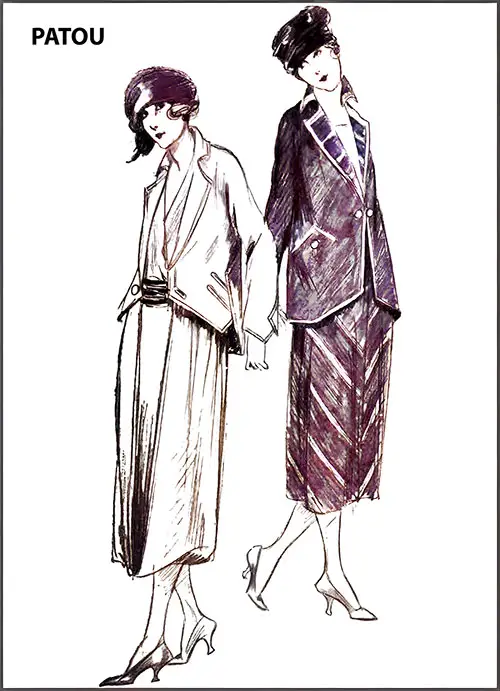
Jean Patou Designed Outfits. Harper's Bazar, May 1921, p. 89. GGA Image ID # 1cc7220102
We may begin with snug and business-like traveling coats: tweeds, Kashavella, and mouflon in browns, with a fair sprinkling of plaids, make good, straight coats. They are not very ample, shirred, or fitted in slightly at the waist, with high collars and roomy sleeves.
Big pockets stitched heavily in silk are the only trimming of a beige Kashavella; a green plaid coat has a big, round cape lined with plain green cloth. The new stuff, Pelissa, makes good wraps like a thick plush or a tremendously rugged melton.
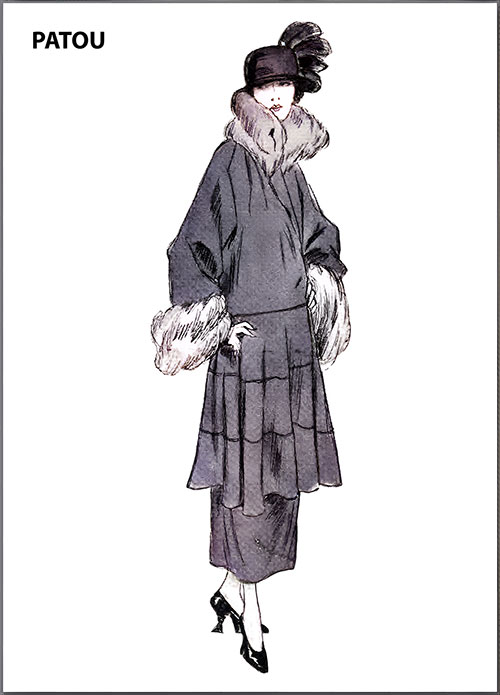
Rose Red Velvet With Gray Fox by Jean Patou. Harper's Bazar, July 1921, p. 77. GGA Image ID # 1cc73fc203
The day's success went to a coat made of the new shawl stuff I have described elsewhere. A bright selvage edges immense woolen squares with a different color at the corners.
A straight mantle of two dark blue squares edged in bright blue has hems at the sides. The intersection square occurs at the hips and is wool embroidered and weighted down by a large tassel. Another model has an interesting collar of natural white and brown skunk stripes.
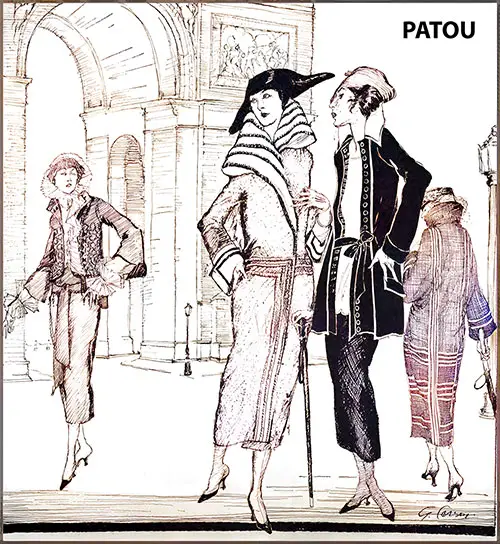
Coats for Spring by Jean Patou. Harper's Bazar, April 1921, p. 68. GGA Image ID # 1cc75ab857
Frills are a pronounced feature of the openings and a refreshing one for spring. Charlotte's long-waisted Eton coat of blue serge, much embroidered with yellow wool, is worn with a blouse of yellow organdie, deeply frilled at the collar and front and doubly frilled at the wrists. Pear-shaped buttons and beads of yellow wood are odd touches.
Patou slightly pouches the back of a dark blue serge coat, leaving the front straight. The shawl collar and deep cuffs of white serge are banded with narrow stripes of blue serge embroidered with white. These bands also constitute a girdle and front panel.
The blouse forms part of most of the new tailleurs, forming, in effect, a waistcoat. Chanel uses a white crêpe de Chine blouse to complete a straight little coat of black charmeuse. A striking coat of blue broadcloth from Patou is plaided with yellow bands in an interesting manner. The collar is notable.
Tailleurs, no matter the coat's length, are straight and rather plain. One departure from the rule of high collars is a little black serge bound in a narrow black braid, the medium-length coat made like a man's smoking jacket.
Duvetyn is used for tailored and one-piece suits; plaids are popularly allied to basic stuff, and velvets strike a dominant note. Although monkey fur does not have the vogue it previously enjoyed, every house persistently uses it on a model or two, principally as a fringe.
The tunic skirt, wound flatly around the wearer and ending off irregularly to one side, is well carried out here; pointed side panels and detached strips are frequent.
The many plaid dresses deserve description. First, this fancy stuff is the foundation of a blue serge coat dress, fastening up one side from the collar to the waist and thence open, revealing the cheerful highland underneath.
On the same order is a gay morning suit of blue and yellow plaid, with a monkey collar worn over a striped yellow lining.

Coat and Tailored Dress by Jean Patou. (l) Blue Serge Coat Trimmed With Red Selvedge, Square of Embroidery and Tassels at Side. (r) Tailored Dress of Beige Duvetyn Trimmed With Beaver. Garment Manufacturers' Index, October 1920. GGA Image ID # 1a3acff6e0
Two breadths of stuff give the best straight effect, split up the sides over a contrasting lining. The material is heavy; it falls off itself. With flimsy fabrics, it is thought more graceful to turn the panels in at the hem; hence, the numerous but varied specimens we meet in every collection of this elegant style.
A blue serge over black satin is sparingly embroidered at the sleeves and shoulders in triangular motifs of bright blue and silver Arab work.
Embroidery, silk or wool, is minute and fine; all-colored wools on blue are charming, and ton-sur-ton carpet-like arabesques give body to lightweight stuff.
The simple, elegant afternoon gowns have round necks and short sleeves, and the turned-in hem is almost invariably a feature. One of these, a mouse charmeuse, escapes monotony by being much shirred and slit up the sides at intervals showing a Nattier lining not concealed by orange, waxed satin ribbons.
Soft old blue is trimmed with yellow ribbons. Another pale blue brocade has a deep yoke, sleeves, and hem formed by faithful tracing over the red and gray silk design. A royal blue velvet has a blue lamé sash and opens over a similar vest.

Jean Patou Has Designed a New Series of Black Frocks and Suits. Harper's Bazar, December 1921, p. 33. GGA Image ID # 1cc76c8fe3
According to the favorite Parisian custom, dinner dresses are black over black or combined with gold or silver. The long-waisted bodices are often crossed or relatively high with straight shoulder lines.
Detached loops of uneven lengths, caught in or not at the hem, give the popular line. Lace aprons occur several times; a black satin has one net traced closely in emerald silk, the sides folded over and forming the slightest hint of a drapery.
For the evening, when gold-shot lamés are plentiful, the Turkish trouser effect given by the shirred-in hem goes very well with this beautiful oriental stuff.
We have plenty of trains, classical and otherwise. It is the case of a pink and silver worn over silver lace with the lamé dividing in the back into two long panels of unequal lengths, caught together and knotted at the feet to form a single train.
There are few draped dresses, but a good many velvet ones. The skirt is cut into panels and embroidered, combined with silk muslin or, newcomer, with a thick silk fringe.

Patou Dress of Crêpella "Les Motifs Afghans" From Rodier, Lettuce Green and Black Opening Over a Black Crêpe de Chine, Front Finished off by Five Crêpe de Chine Ruffles in Lettuce Green. Garment Manufacturers' Index, April 1921. GGA Image ID # 1a3af8d1f5
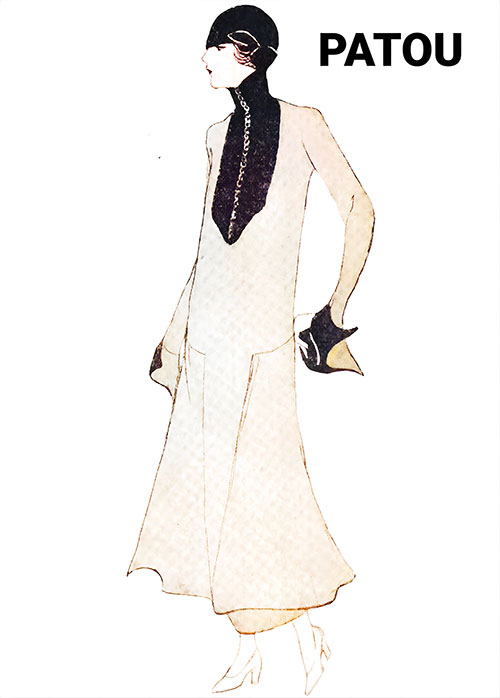
A Navy Serge Trotteur From Patou, With Vest and Cuffs of Black Satin, Adheres to the Three Fashion Decrees of the Winter. It Is Beltless, Its Circular Flare Is Prominent, and Its Foundation Skirt Is Narrow. the Circular Side Pieces Are Attached to the Sides of the Back Panel and Are Full Enough to Meet in Front. the Vestee, a Versatile Piece, May Be Buttoned up to the Chin With Tiny Black Buttons or Unbuttoned to a Discreet Depth, Allowing the Wearer to Express Their Style. a Swathing Headdress of Black Velvet Emphasizes the Note That Many Hats Fit As Tight As Possible. The Ladies' Home Journal, November 1923. GGA Image ID # 21820be0c1
Jean Patou's spring "opening" was brilliant, and the steady increase of buyers in his salons proved its success.
The numerous models shown give an impression of good classical lines combined with original details. Jean Patou possesses the elusive Parisian grace, which, by a trifling detail, manages to provide the simplest, most practical gown, just the chic that makes one look "different" in it.
The strong personality shown in each model makes this collection a pleasure to view.

White Wool Reps With Plaited Inserts and Black and Yellow Embroidery by Jean Patou. The Ladies' Home Journal, May 1923. GGA Image ID # 2181a9bc8f
One of the house's specialties is wonderfully tailored suits. This year, they favor the smoking jacket or boléro worn with rather fuller gored or side-pleated skirts, be they summery taffetas or more sober serges.
A Norfolk suit of red leather attracted all eyes, while a characteristic blue serge with a braided boléro gave a valuable idea. It is lined with cherry brocade which also forms the loose, graceful revers of the coat.
A highly diverse collection of coats held to the wearer and shapeless, therefore indescribable, precede a goodly array of three-piece suits that are ever favorites this season.
"Garibaldi," a gay little model of blue serge lined with red matching a scarlet Georgette bodice, was much commented on.
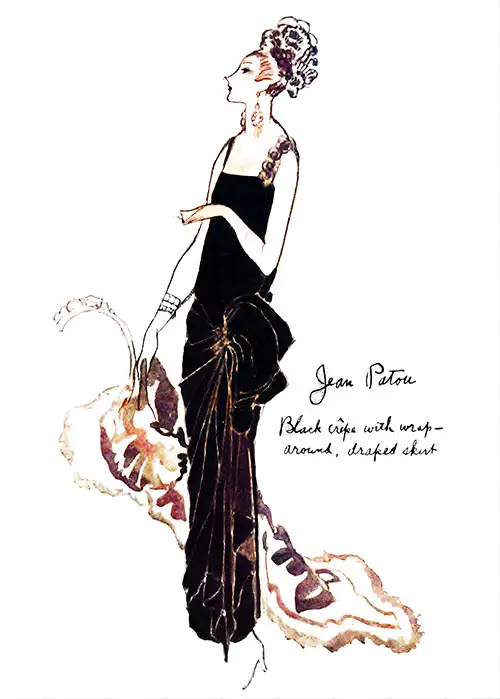
Black Crepe with Wrap-Around Draped Skirt by Jean Patou. The Ladies' Home Journal, May 1923. GGA Image ID # 2181c4e628
Numerous afternoon and evening dresses abound, affording a harmonious, slightly blurred line. Crêpe marocain, lace, tulle, cut into panels, aprons, scarves, and shaped gores blend indefinitely, giving an impression of extreme grace and lightness.
Different laces relieved and underlined by bright chiffon scarves, tulle banded with ribbon in transparent, soft colors, and hand-painted, slightly draped muslins make perfect dinner and afternoon gowns.
For more formal occasions, gorgeous brocades and lamés, given a straight cut to enhance the tone values of the stuff, complete this excellent collection with a delightful series of ample voile and organdie gowns worn over bright linings.
The Flower of the Mode: Patou
HAVING first assured my readers that the new Patou winter collection is a huge success; I'd like to tell them what Jean Patou has to say about it himself.
He assured me that the sports clothes in the collection are designed with a practical purpose in mind, without any sensational novelties.
Modern sports women find what they are wearing practical, so there is no occasion for me to invent anything new that might not be better. Anyway, is there anything more suitable for sports wear than a sweater?
"For the afternoon and evening, however, I have decided on novelty. My evening models have significantly changed from last season's.
"For one thing, my skirts are much longer, veiling the limbs.
This new fashion of longer or partly lengthened skirts produces a beautiful line. "
Monsieur Patou went on telling me about the new departures featured in his collection but was suddenly called away; however, not before he had, as a parting shot, found time to say that he considered this collection of his to have signed the death warrant of the short, straight-all-around dresses, "which have been the triumph of the last few seasons." Having made this significant remark, he hurried away.
The way Patou stage-manages his collections is always interesting. His presentations always have a dramatic quality, which is most likely why he can keep us all in breathless suspense until after 1 A.M., as he did on the night he showed his creations to friends and press members.
The collection started with three breezy mannequins attired in ultra-smart sports clothes. I envision bright-colored sweaters, gay polka dots, knitted caps, cardigan waistcoats, flying scarfs, tweed plus fours, rolled socks, and heavy boots!
They were followed by a girl wearing a navy yachting outfit with gold buttons. She was wearing a white woolen gilet over a light sweater with a woven design that looked like a pyramid of squares in front of it. These pyramids of squares and the huge colored dots are typical of this season's Patou sports patterns.
Next appeared " Golf," a gray tweed cape with sleeves to be worn over a skirt and sweater, a typical Patou costume. Delightful is a short black velveteen skating skirt, shown with a pink woolen sweater and a muffler and cap to match. "Pepper and salt" tweed made into a serviceable coat and divided skirt is an excellent shooting suit. A little bird's wing completes it in shimmering green perched on a slouchy felt hat.
For early Riviera wear, Patou shows excellent examples of what the smart Parisienne will wear--white crêpe or flannel, red, blue, or white woolen jackets, colored scarfs, and crêpe ' kerchiefs to tie on the hair.
A series of tennis outfits for the coming Cannes season is exceptionally stylish. The most attractive is " Helen Wills, " consisting of a white gown with a scarlet sweater beneath a big scarlet kasha cape profusely trimmed with cream-colored lynx. A crownless hat brim in white and red, shaped like a tennis visor, completes the costume.
Small-patterned velvets in subdued shades are popular for afternoon wear. Such dresses do not have embroidery, and most coats and gowns are made of the same printed velvet.
The much-heralded 1880 inspirations have, at Patou's, taken the
form of frills rising from front to back and used a great deal for
simple crêpe or marocain gowns of the kind the Maison Patou is
famed for.
The waistline in this house seems, in most instances, to have
comfortably settled in its most normal position.
A sapphire-blue velvet wrap combined with a sapphire chiffon gown is one of the richest-looking ensembles in the entire collection. The beautiful wrap is trimmed with Canadian marten, and the gown's normal waistline dips low in the back.
A sapphire-blue velvet wrap combined with a sapphire chiffon gown is one of the richest-looking ensembles in the entire collection. The beautiful wrap is trimmed with Canadian marten, and the gown's normal waistline dips low in the back.
Slate blue is this season's " Patou color novelty," it is especially striking when used for beaded gowns this year. The beading is in the form of texture rather than embroidery.
The beautiful Alicia appears in a white figured crêpe evening gown with a long overskirt of white fringe reaching her feet. The waistline of this gown is worn very high up. This model seemed to be one of the most attractive evening dresses in the entire collection.
The same girl also appears wearing " Ispahan" and "La vie en rose," pink velvet and pink satin gowns. In both cases, long points of velvet or satin reach down to the floor, both front and back.
This magnificent collection closes with several wide netball dresses in varying colorings and the appearance of a blushing bride in a wonderful white satin wedding dress and veil.

Beach Suit of Black and White Crêpe by Patou. (Harper's Bazar, July 1927) | GGA Image ID # 226846ff4b
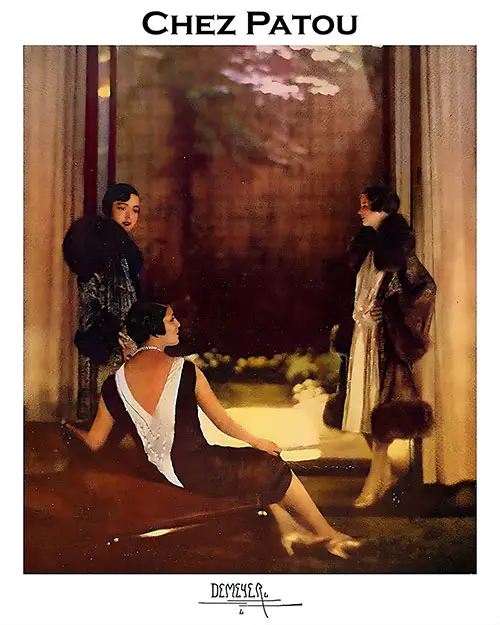
Chez Patou. Photo par Baron De Meyer. Tous Les Modeles Deposes. (Harper's Bazar, October 1927) | GGA Image ID # 226f49d553
Chez Patou (October 1927)
The Patou collection is a superb monument of reticence and good taste. Though rich, because of texture and detail, the collection in its final analysis might be summed up in two words: " Sumptuous simplicity! " The beautiful modern supple textures, as Patou treats them, lend themselves magnificently to his particular style of smartness.
Patou models do not look like models, nor do the girls who show them look like mannequins. On the contrary, they give the impression of being stylish society women of the kind one might meet at Cannes and Biarritz-come across from the Ritz to walk through Patou's salons.
Sports clothes in this collection are what every woman needs and craves for the quintessence of smartness. The well-known Patou belt stripes are still noticeable on most sweaters. Over these, cardigan jackets or fur-lined paletots in English materials look extraordinarily serviceable.
All colorings are exquisite, and Patou chooses the shades with the utmost care. The predominant notes are deep black, white, beige, brown, gray, and a range of blue—from an inky shade to the palest Nattier and a lovely fuchsia.
The use of stiff satin is new at Patou's, especially of taffeta: flounced taffeta, bunched taffeta, and draped taffeta. Mousseline de soie and supple velvets are treated almost identically. At the same time, Patou uses embroideries profusely, which are all novel in treatment. As to afternoon gowns, they are remarkably varied in style and handling. Some might even be simplified " robes de style."
In contrast, others cut with slenderizing godets are true Patou classics—a few new color combinations and other personal impressions: bronze velvet with red fox.
An assemblage of lavender, violet, and navy produces soothing and luxurious harmonies. The 'Amour Amour' gown, a very full black chiffon-almost a picture gown, exudes luxury and indulgence. The two evening coats, 'Les Epis d'Or,' one of white, the other of champagne-colored brocade woven with golden wheat ears, are a delightful series of full tulle ball gowns with layers of superposed frills, offering a sense of pampering and extravagance.
These coats have Russian sable collars. They are a delightful series of full tulle ball gowns with layers of superposed frills. These frocks are shown in beige, blue, gold, and white.
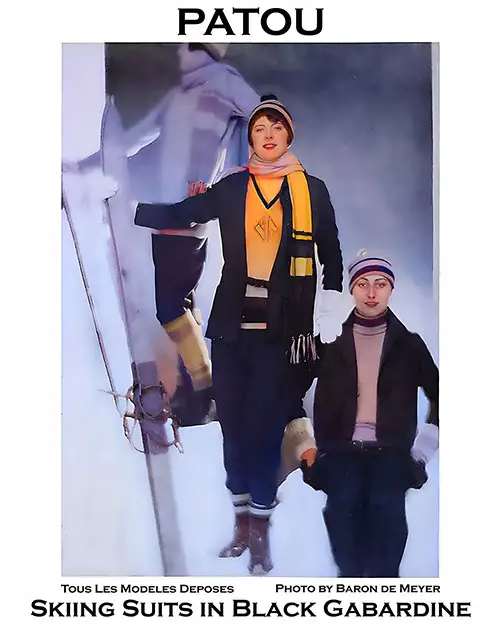
Skiing Suits in Black Gabardine by Patou. Photo by Baron de Meyer. Tous Les Modeles Deposes. (Harper's Bazar, December 1927) | GGA Image ID # 2272f998d4
Bibliography
"Jean Patou" in the Garment Manufacturers' Index, New York: The Allen-Nugent Co. Publishers, Vol. II, No. 3, October 1920: 24-25.
"Jean Patou," in Garment Manufacturers' Index, New York: The Allen-Nugent Company, Vol. II, No. 9, April 1921, p. 20.
Baron de Meyer and Marjorie Howard, "What Is New in Paris: The Autumn Collections of The Great Paris Houses: Chez Patou," in Harper's Bazar, New York: International Magazine Company, Inc., Year 61, No. 2580, October 1927: The Paris Openings Number, Illustrated By Baron de Meyer, Bernard B. Demonvel, Mary Mackinnon, Reynaldo Luza, and Dynevor Rhys, p. 78.
Bayon de Meyer, "The Flower of the Mode: Worth," in Harper's Bazar, New York: International Magazine Company, Inc., Year 63, No. 2592, The Paris Openings Number, October 1928, p. 70-72.
✨ Most Engaging Content Highlights
The Cohesive House Aesthetic 🧵
Patou maintained an unwavering silhouette—straight, clinging outlines, subtle flair at hips, and smart tailoring from daywear to evening gowns. This consistency is particularly notable for those studying fashion branding and early 20th-century visual identity.
Ocean Travel Fashion Connection 🚢
Many Patou designs were clearly made with travel practicality in mind. His tailored coats, tweed ensembles, and resort wear (like tennis and beach suits) balanced fashion and function. This makes Patou essential to any curriculum focused on shipboard fashion or interwar leisure class culture.
Use of Fabric Innovation 🧶
Materials like Kashavella, Crêpella "Les Motifs Afghans", Pelissa, and marocain were employed to enhance drape, comfort, and warmth. Patou's deft pairing of luxurious and practical materials—like monkey fur fringe, duvetyn, and serge—reflects a designer deeply attuned to the needs of the fashionable traveler.
Sportswear & the Modern Woman 🎾
Patou revolutionized sportswear, creating pieces for tennis, shooting, yachting, and skating. His “Helen Wills” ensemble (red cape and crownless hat) for the Cannes season highlights how sport and fashion coalesced in glamorous ways aboard cruises or in resort towns.
Theatrical Presentation & Modern Marketing 🎭
Patou's dramatic fashion shows, held into the early hours, added flair and created media buzz—an early precursor to today’s fashion week presentations. It also emphasizes the importance of staging and branding in luxury fashion's evolution.
🖼️ Noteworthy Images
🖼 Rose Red Velvet With Gray Fox (July 1921)
This striking contrast in textures evokes warmth and aristocratic flair, perfect for an ocean liner’s upper deck in cooler weather.
🖼 Beach Suit of Black and White Crêpe (1927)
A marvel of modernist simplicity, this suit illustrates the ease and polish of Patou’s resort wear—designed with Riviera and shipboard elegance in mind.
🖼 Navy Serge Trotteur with Vest & Cuffs of Black Satin (1923)
The clean lines and versatility of this outfit embody Patou’s genius in practical, elegant ensembles that could transition seamlessly from promenade deck to port city.
🖼 "Garibaldi" Red Serge Suit with Scarlet Georgette Bodice
This nod to military tailoring channels power and femininity—an ideal look for transatlantic arrival or European sightseeing.
🖼 Patou’s Crêpe de Chine Dresses with Lettuce Green Ruffles
These show Patou’s flair for color blocking and panel layering, engagingly modern in movement and adaptable for onboard evenings.
📚 Mini Dictionary of Terms
Boléro: A short, open jacket worn over dresses or blouses.
Crêpe Marocain: A textured silk fabric with a heavier drape.
Duvetyn: A soft, woolen fabric with a napped finish.
Kashavella: Likely a wool blend used for coats; known for durability.
Selvedge: The tightly woven edge of fabric, often used decoratively.
Tailleurs: Tailored women's suits or ensembles, often skirt and jacket.
Trotteur: A tailored outfit suitable for travel or walking.
🎓 Educational Relevance & Encouragement
Students writing about fashion evolution, the role of women in travel, post-WWI identity, or the democratization of luxury will find Jean Patou’s collections a goldmine of insights. Teachers can incorporate this content to demonstrate the intersection of fashion, travel, and societal change. Genealogists and historians can reference Patou to better understand the daily lives and appearances of ancestors who traveled during the Golden Age of Ocean Liners.
📚✍️ We encourage students to use GG Archives materials when researching or writing essays—these primary sources offer a vivid, first-hand look at style, society, and innovation in early 20th-century transatlantic life.
